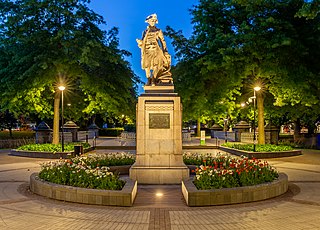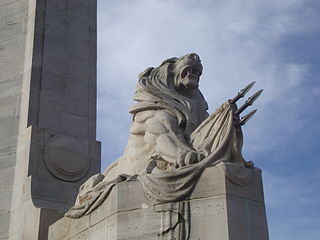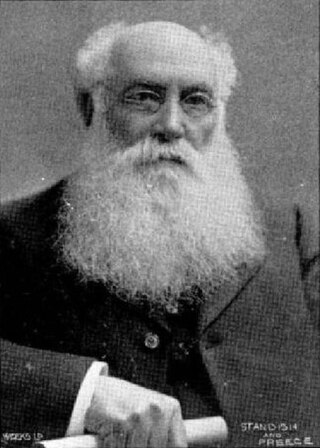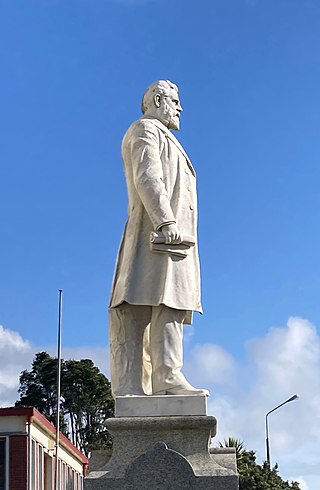
Cathedral Square, locally known simply as the Square, is the geographical centre and heart of Christchurch, New Zealand, where the city's Anglican cathedral, ChristChurch Cathedral is located. The square stands at the theoretical crossing of the city's two main orthogonal streets, Colombo Street and Worcester Street, though in practice both have been either blocked off or detoured around the square itself. The square was badly damaged in the February 2011 Christchurch earthquake.

Moutoa Gardens, also known as Pākaitore, is a park in the city of Whanganui, New Zealand. Named after the Battle of Moutoa Island in the Second Taranaki War, it contains a memorial to the battle inscribed "To the memory of the brave men who fell at Moutoa, 14 May 1864, in defence of law and order against fanaticism and barbarism." It also contained a statue of John Ballance, organiser of a volunteer cavalry troop in Tītokowaru's War and later Premier of New Zealand, but the statue was beheaded and a replacement installed outside the district council building. A number of items present in the park are registered by Heritage New Zealand.

The Wellington Cenotaph, also known as the Wellington Citizens' War Memorial, is a war memorial located on the intersection of Lambton Quay and Bowen Street in Wellington, New Zealand. It commemorates the war dead of the two world wars. The cenotaph is listed as a Category 1 Historic Place by Heritage New Zealand and it is the city's focus for the annual Anzac Day commemorations.

Colombo Street is a main road of the city of Christchurch, New Zealand. It runs south-north through the centre of Christchurch with a break at Cathedral Square. As with many other central Christchurch streets, it is named for a colonial Anglican bishopric, Colombo, Sri Lanka in what at the time was known as Ceylon. Parts of the street which run through Sydenham were known as Addison Street during the 1880s, and some parts were known as Colombo Road.

The Rolleston Statue is a white marble statue situated outside Canterbury Museum on Rolleston Avenue in Christchurch, New Zealand. It commemorates William Rolleston, who was Superintendent of the Canterbury Province from 1868 until 1877.

The Lyttelton Times Building, last known as Base Backpackers, in 56 Cathedral Square, Christchurch Central City, was the last headquarters of the Lyttelton Times before its demise in 1935 as the then-oldest newspaper in New Zealand. The building in Chicago School architectural style was registered with New Zealand Historic Places Trust as a Category I heritage item, with the registration number 7216. The building's last use was as a backpackers' hostel and a restaurant. It was demolished following the February 2011 Christchurch earthquake.

The Citizens' War Memorial in Cathedral Square, Christchurch, is one of the two major memorials in the city to World War I. It is located immediately north of ChristChurch Cathedral. The annual Anzac Day service was held there until the February 2011 earthquake; since then the memorial has been behind the fence around the cathedral. It is a Category I heritage structure registered with Heritage New Zealand. Between 2021 and 2022, the memorial was repaired and shifted 50 metres (160 ft) to the west. The Citizens' War Memorial was used for the 2023 ANZAC day dawn service in Christchurch.

The Bridge of Remembrance is one of two main war memorials in Christchurch, New Zealand. It is dedicated to those who died in World War I, and serves as a memorial for those who participated in two World Wars as well as subsequent conflicts in Borneo, Korea, Malaya, and Vietnam. Owned by Christchurch City Council, it is located on the Cashel Street Bridge at the head of City Mall. The Bridge of Remembrance was repaired and strengthened following the 2011 Christchurch earthquake and was reopened with a rededication ceremony held on Anzac Day in 2016.

Matthew Frank Barnett, also known as Mat Barnett, was a bookmaker and philanthropist from Christchurch, New Zealand. In his retirement, he became well known in lawn bowls. He donated the statue of James Cook in Victoria Square to the city. His family dwelling, Wharetiki House, was a prominent landmark on Colombo Street in the Christchurch Central City until its demolition in July 2011, following a demolition order by the Canterbury Earthquake Recovery Authority.

The Cook Statue in Victoria Square, Christchurch, commemorates the three journeys of James Cook to New Zealand. The statue, sculpted by William Trethewey, was unveiled on 10 August 1932 by the Governor-General, Lord Bledisloe. It was donated by bookmaker and philanthropist Matthew Barnett (1861–1935).

Cecil Walter Wood was a New Zealand architect. He was the dominant architect in Canterbury during the interwar period.

Joseph Clarkson Maddison was a New Zealand architect. He trained as an architect in his native London and came to Canterbury at the age of 22. At the end of the 19th and beginning of the 20th century, he was one of the most prominent architects in Christchurch, receiving commissions from all over the country. Until the February 2011 Christchurch earthquake, 13 of his buildings were listed by Heritage New Zealand on their register, with three of those Category I listings, but many of the Christchurch buildings have been demolished since. His style was plain and utilitarian, and he specialised in the classical Italian mode.

Frederick George Gurnsey was a New Zealand carver and art teacher. He was born in Newport, Monmouthshire, Wales on 18 January 1868. He did the carvings for the Bridge of Remembrance in Christchurch. The carvings in the sanctuary of the Nurses' Memorial Chapel at Christchurch Hospital are by Frederick Gurnsey and Jack Vivian. His carved mural in the Canterbury Pioneer Women's Memorial is not regarded as successful.

Samuel Charles Farr was a 19th-century builder and architect in Christchurch, New Zealand. He intended to emigrate from England to Auckland, but significant shipping problems saw him end up in Akaroa in 1850 instead. From 1862, he lived in Christchurch. Farr has a number of firsts against his name: the first marriage in Canterbury, he designed Akaroa's first church, designed New Zealand's first iron verandahs, and he started Sunday schools in Canterbury. As a leading member of the Acclimatisation Society, he stocked almost every lake and river in Canterbury with fish and was instrumental in introducing the bumblebee to New Zealand. His most notable building was Cranmer Court, the former Normal School, in the Christchurch Central City; this building was demolished following the February 2011 Christchurch earthquake.

Robert Burns is a bronze portrait statue of Robert Burns by John Steell. Four versions exist, in New York City, Dundee (Scotland), London (England), and Dunedin.

The Cenotaph in the southern New Zealand city of Dunedin stands in the centre of Queens Gardens, close to the city centre. It is the city's main war memorial.

The Statue of Margaret Cruickshank is located in Seddon Square, in the small rural town of Waimate, New Zealand. It honours the life of Margaret Cruickshank, a local doctor who died in the influenza pandemic of 1918, and was the first monument erected in New Zealand to a woman other than Queen Victoria.

William Henry Feldon was a sculptor, architectural sculptor, and monumental mason from Oxford, England who migrated to New Zealand in 1910. He is best known for his series of First World War memorials—where annual Anzac Day services are held—and his contributions to iconic public buildings in New York, New Zealand, and England.

This statue of Richard Seddon is in Hokitika, on the West Coast of the South Island of New Zealand. The statue is situated on Sewell Street, outside the Government Buildings known as Seddon House.

A statue of Queen Victoria was erected at Albert Park, Auckland, in 1899. The second monument to Queen Victoria in New Zealand, the bronze statue was funded by public donations encouraged by Auckland politicians and the New Zealand Herald in celebration of the Queen's Diamond Jubilee. Following applications from various British and New Zealand artists, the statue was commissioned to British portrait sculptor Francis John Williamson. It was one of nine variants of his 1887 statue erected at the Royal College of Surgeons, allegedly a favourite of the future Edward VII.


























